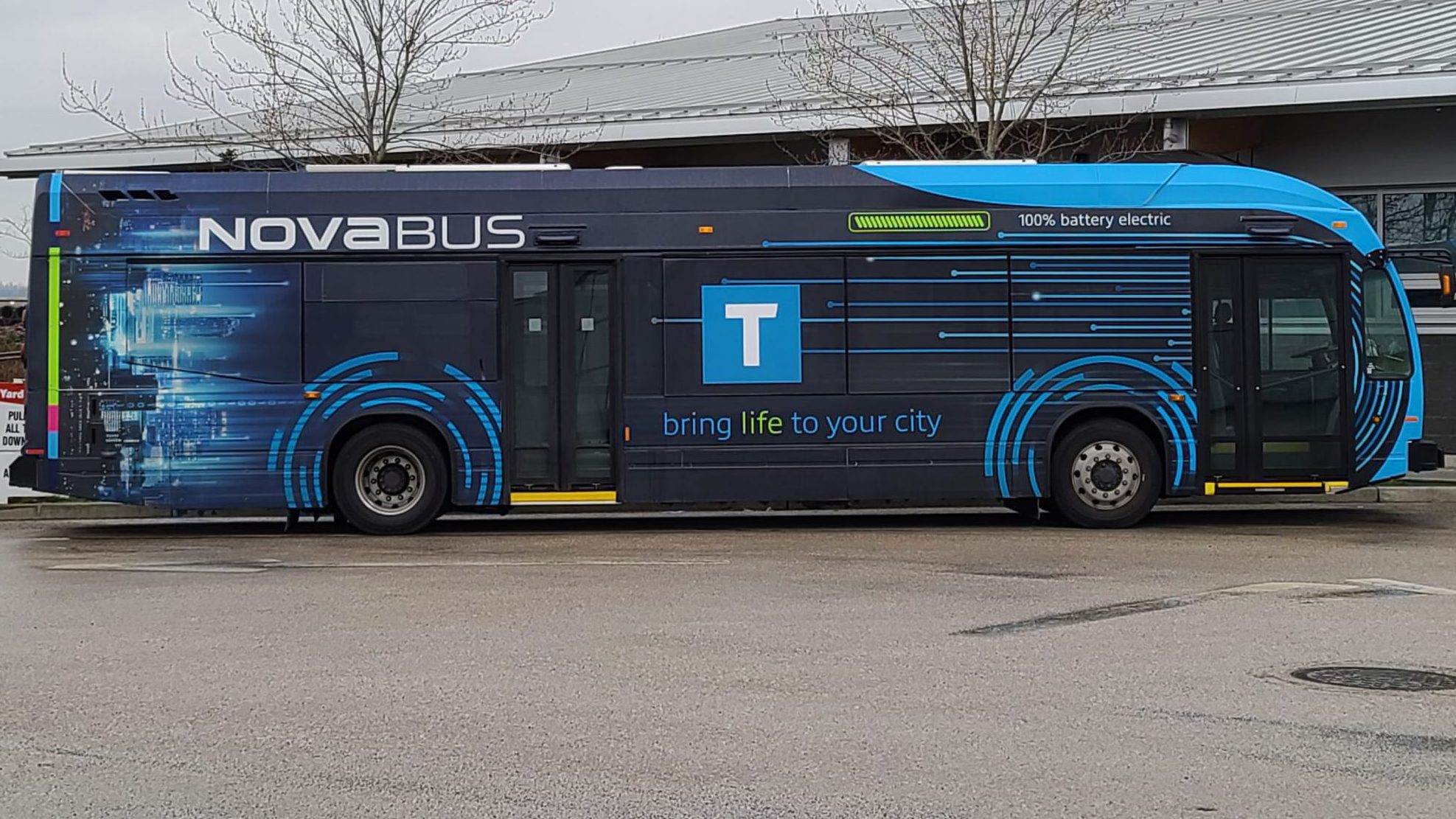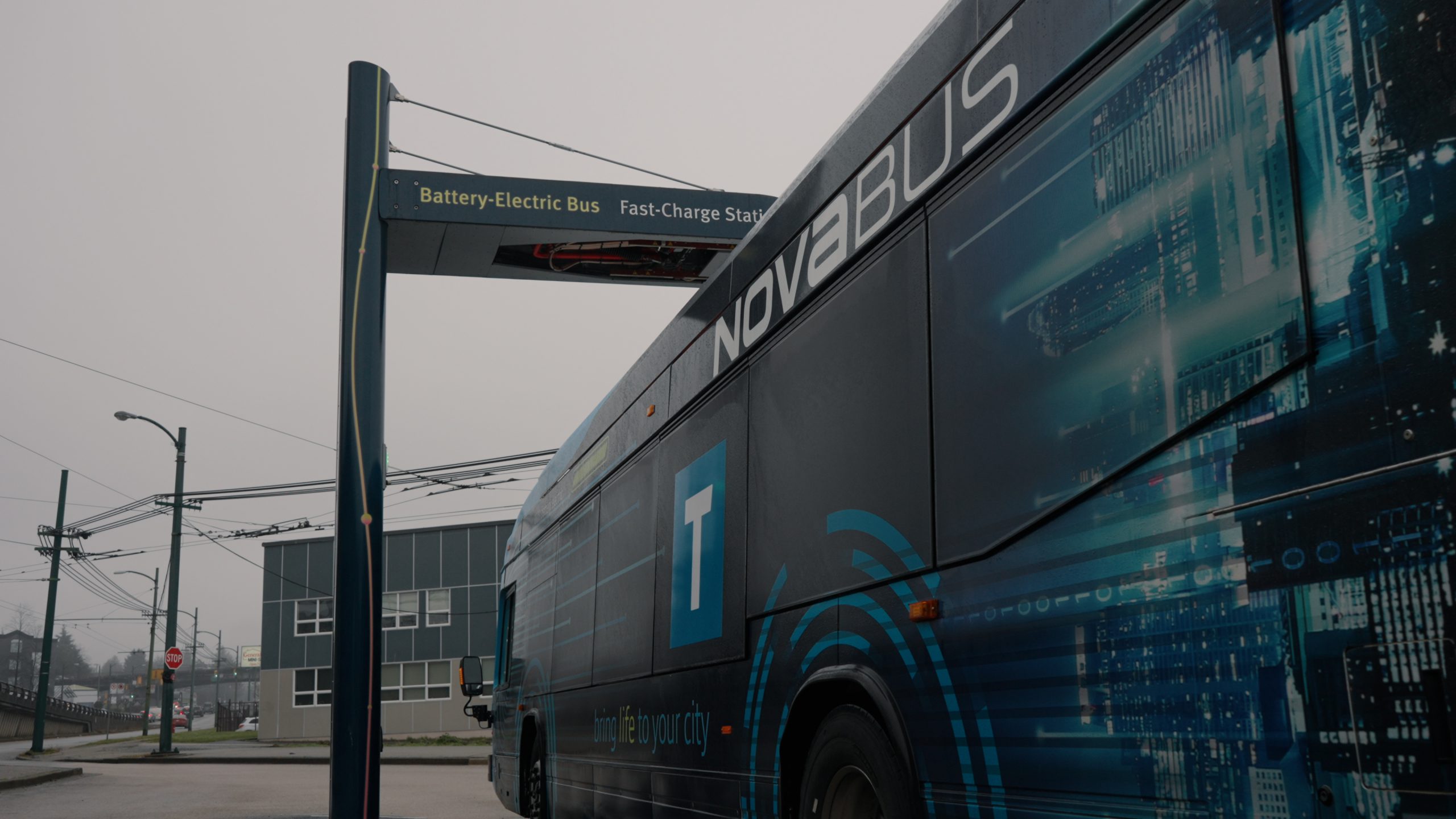TransLink tests next generation of battery-electric buses
TransLink tests next generation of battery-electric buses

As part of our Climate Action Strategy, TransLink is replacing old diesel buses with battery-electric buses to reduce greenhouse gas emissions (GHGs). Currently, we have four battery-electric buses in service with 15 more on the way. To make sure those 15 new buses will be effective and efficient for many years, we’re running tests on a demo bus provided by Nova Bus.
Here is a breakdown of what we’re testing on Nova’s LFSe+ battery-electric bus:
Distance
These new Nova buses should be able to travel over 150 kilometres on a single charge, even during winter months. This is something we’re testing to have a clear picture of capabilities before they roll into service.
The two Nova buses we have in service currently can only travel roughly 40 kilometres on a single charge, so the newer model would be a major upgrade. This means the ones we have now need to continuously use on-route charging stations to serve customers throughout the day. The newer models should have more flexibility in how often they need to charge.
Charging
To ensure the battery-electric buses can continuously recharge throughout the day, we use on-route overhead fast-charge stations. These chargers:
- Top up our battery-electric buses for the next trip in under six minutes.
- Can charge buses while passengers board.
- Use an automated overhead mechanism that charges quickly through the bus roof.
We currently have two fast-charge stations located at 22nd Street Bus Exchange and the Marpole Loop – one manufactured by ABB and the other by Siemens. We are currently testing this new Nova Bus model to ensure they are operable with these chargers and that they meet or exceed the charging capabilities of the in-service buses we have now.
Operability in winter
Battery-electric buses operate differently in winter than they do in the summer. Most differences are minor like slower acceleration and slower charging abilities, but these minor differences can have a major impact on scheduling. To give our planners more information, we are testing vehicle efficiency, how quickly the buses start up in the morning, their acceleration capacity, and charging speeds during the winter.

Once the tests are complete, we will use the results to potentially request modifications on the 15 buses before we receive them to ensure they run effectively and efficiently for many years. This will also help to inform our decisions for orders of battery-electric buses we make in the future.
Other battery-electric bus facts:
- Each battery-electric bus saves approximately 100 tonnes of GHGs annually compared to a conventional diesel bus.
- TransLink plans to replace over 400 diesel buses with battery-electric buses by 2030.
- This will equate to over 40,000 tonnes of GHGs annually.
- TransLink plans on having a zero-emission bus fleet by the year 2040.
- Each battery-electric bus saves TransLink approximately $40,000 in fuel annually, compared to a conventional diesel bus.
Dan Mountain
I'm just a guy who hates bios, but likes trains... and buses... and SeaBuses.






Old recycled news. Toronto already has 60 electric buses!!
And your point is?
we are up to 5 years behind many other juresdictions
Translink is a transportation company for Metro Vancouver, BC. I don’t consider this “old recycled news” when this is actually news. There is no claim that this is the first electric bus in the nation or the world. In fact, if I were to use the same logic you applied for your comment, I’d say your news of “Toronto already has 60 electric buses!!” is old and recycled news itself since the first electric bus utilized was in another country (USA and India) in 2014. If your angle was regarding Toronto being the first electric bus in Canada, I’d like for you to understand the carbon footprint difference between the two provinces. https://www.canada.ca/en/environment-climate-change/services/environmental-indicators/greenhouse-gas-emissions.html
Toronto just installed a rail link to Pearson Airport. Here’s the Hypocrisy
IT’S THE ONLY TTC RAIL LINE THAT USES DIESEL POWER! DIESEL ON THE LINK FROM DOWNTOWN TO AIRPORT.
And then brag about 60 battery busses that are going to pollute the world with deal batteries in a few years.
Absolutely Ridiculous Virtue Sharing.
Actually, the diesel rail line isn’t operated or owned by the TTC. It’s actually owned and operated by Metrolinx, who also owns and operates GO Transit, and they have countless amounts of diesel commuter rail lines that form the GO Train network. I don’t know what makes you think that the UP express is operated and owned by the TTC, as the TTC only owns and/or operates subways, buses and streetcars.
Point is…Translink is a management heavy dinosaur that needs to cut the fat at the top!! We need more buses not more overpaid executives feeding like hungry piglets at the public teet.
TransLink is up to 5 years behind other jurisdictions in electric buses and green garages,
Here is a link for Greening Government Fleets
https://bcwidebus.files.wordpress.com/2020/08/nrcan_greeninggovfleets_e.pdf
Why oh why do you think its a good idea to vinyl wrap over all of the windows? The dot matrix makes it hard to see out and simply makes me feel sick from motion sickness. I will never ride a bus that is wrapped like this one. Is it really important to cover the windows and make a miserable ride experience for paying passengers? Come on Translink, you can do better than this!
Hi David, this is a test bus and not for passenger use. Our in-service battery-electric buses do not have the windows covered.
I agree. The point is… It is necessary to trim the fat at the top of Translink, which is a management heavy dinosaur!! We need more buses, not more overpaid executives who graze on the public teet like a bunch of starving piglets.
What a gratuitous cheap shot. Your comment is political and not particularly informative. The article is about adoption of electric buses in Vancouver. Why don’t you find another forum for ranting ?
Wow, this is really exciting! I’m super stoked that we are seeing such awesome progress in our jurisdiction! Can’t wait to see what Translink does next.
In Burnaby, we have the world’s leading designer and manufacturer of proton exchange membrane electrical power supplies who deliver GHG free energy to busses in operation in several countries in Europe and south east Asia but, British Columbia. as far as I’m aware, is not even testing this power source for our transit system. The NDP, who should cherish the benefits from the employment of our own taxpayers, should at least be supporting a local manufacturing source, when it is available.
I would also point out that some Baltic States are also using these fuel cells to power ferries and trains that are actually in service. Another possible source of employment and votes which seems to be ignored
I’m beginning to think that John Horgan is (secretly) a Conservative
Electric buses are wonderful, and it is good that Tranlink is finally starting to investigate electric buses. Their choice of bus company is more than questionable.
Novabus is produced by the Volvo Group, which is owned by Zhejiang Geely Holdings Group, based in Hangzhou, China. The purchase of Volvo Group by Zhejiang Geely Group was supported by the corrupt autocratic communist Chinese Government.
Why is Translink buying its electric buses from a Chinese Government-supported company based in China, when there is a Canadian bus company, NFI Group (New Flyer) based in Winnipeg who has been selling their electric buses all over the world, most recently to Texas, Scotland, Florida, Denver, etc.
They have even sold their double-decker electric buses to Hong Kong!
I was wondering this exact same thing: why is Translink (and other Canadian transit providers enlisting electric buses) not doing business with Canadian company New Flyer Industries Group (NFI), home base Winnipeg?
Actually, Translink has had electric buses for some time, they’re called trolleys. Granted they can only operate where there are overhead lines but they are pure electric and they don’t require charging!
I’m just wondering, if Translink is going to continue to buy new buses with air conditioning, how will this affect the battery life of these new
electric buses? Will it be a case of having to chose between an all electric fleet, or a feet that serves a much needed need for the travelling public. What with Global warming arriving sooner or later, we’ll need A/C on buses big time. Or will Translink sweep A/C buses under the carpet?